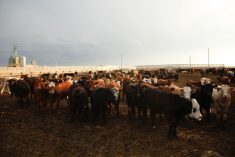Western Canadian feeder cattle prices were relatively unchanged compared to seven days earlier. Buying interest for yearlings was somewhat stronger while calves in the eastern Prairie regions were softer.
Moderate temperatures are in the seven-day forecast for most of Western Canada, so the risk discount due to adverse weather has evaporated. Barley jumped an additional $4-$6 per tonne last week in southern Alberta and cost per pound gains are coming in higher than anticipated. Feedlot operators are extremely cautious and the market is in a very precarious situation.
Read Also

Alberta crop conditions improve: report
Varied precipitation and warm temperatures were generally beneficial for crop development across Alberta during the week ended July 8, according to the latest provincial crop report released July 11.
In the U.S., fed cattle supplies for March and April are rather tight but fundamentals for the third quarter look quite burdensome. Live cattle futures are deceptive because the strength in the nearby April live cattle futures has pulled up the August contract. At the same time, packers are hesitant to contract for July and August delivery.
Medium- to larger-frame Simmental mixed steers with medium flesh levels weighing just over 900 lbs. traded for $169 in central Alberta; Angus mixed heifers with lighter flesh levels weighing 925 lbs. were valued at $145 in the same region. In central Saskatchewan, larger-frame lower-flesh mixed steers weighing 855 lbs. were quoted at $175. Backgrounding operators are in the process of liquidating fall-place calves and yearlings coming on the market were very good quality.
Once again, there was no shortage of demand in the lighter weight categories. November feeder cattle futures are within a stone’s throw of 52-week highs, which has spurred on buying interest for grassers. Next fall, feedlot operators are expecting barley prices to be $30-$40 below current levels so the cost per pound gain will be more reasonable. Year-to-date feeder cattle exports to the U.S. are running 23 per cent above year-ago levels so there is strong buying interest from all angles.
In central Saskatchewan, Charolais mixed steers weighing 555 lbs. were quoted at $220 while red mixed heifers averaging 600 lbs. were quoted at $180. For calves under 600 lbs., Alberta values were $5-$8 higher than in Saskatchewan and Manitoba this past week.
— Jerry Klassen manages the Canadian office of Swiss-based grain trader GAP SA Grains and Produits Ltd. and is president and founder of Resilient Capital, specializing in proprietary commodity futures trading and market analysis. Jerry consults with feedlots on risk management and writes a weekly cattle market commentary. He can be reached at 204-504-8339.















